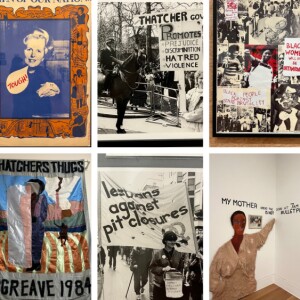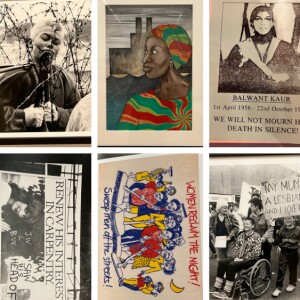Women in Revolt
Art and Activism in the UK 1970-1990 at Tate Britain, Pimlico
I loved this exhibition. It feels more or less like my life. I’ve shown 18 items in roughly chronological order, trying to show a range of the issues covered, though of course it’s really only a tiny selection - probably reflecting what I was most involved in.
Main pic:
. One of the placards from the demonstration against, and disruption of, the Miss World competition in London in 1970
. Jayaben Desai (photo by Sheila Gray) one of the key women at the strike at Grunwick photo processing factory in Brent, in 1976 - the campaign was in relation to low pay and poor working conditions in a factory largely staffed by women
. One of many campaigns, involving a lot of protests and marches, to defend the right to a safe abortion for women who needed one. The right was won in 1967, but in subsequent decades many male MPs tried to bring in amendments to curtail those rights. ‘Every child a wanted child!’
. Married bliss? Or women ‘chained’ at home by children and housework?
. The wedding of Di and Charles - provoked a feminist response to the polar opposite of what we were campaigning for. Plus the archaic ceremony and waste of money. Image by Suzan Swale
. The demand of legal and financial independence for married women was an important part of feminism. Before a partial success in 1975 women were not allowed to have a bank account without her husbands permission, or apply for a loan, a credit card, or a mortgage.
First extra:
. Margaret Thatcher was such a disappointment - the first woman Prime Minister’s policies were almost all anti-women or harmful to women : hospital closures, a deliberate increase in unemployment (a price worth paying said Norman Lamont the Chancellor), increase in VAT, selling off millions of council houses, closing nurseries, cutting millions from education budgets and social provision - to name but a few.
. Thatcherism also provoked women to demonstrate against state racism, violence, and promotion of inequality
. Black women decided to organise and protest in their own right away from the largely white feminist organisations - though mutual support continued, and white women learned to question themselves deeply
. One of Thatcher’s best known crimes was the unleashing of police brutality against the striking miners in 1984 - one of the best remembered occasions was at Orgreave Colliery
. There was a strong connection between feminist groups and miners’ wives groups - and a lot of fundraising and practical support. Also an alliance between striking miners and lesbian and gay groups, as shown in the wonderful film ‘Pride’
. This installation remembers Cherry Groce shot by police at point blank range when she answered her door at 7 am in Brixton in 1985. She was paralysed, and died later of her injuries in 2011. The Metropolitan Police said ‘sorry’ in 2014 - three years after her death, and 29 years after the shooting. The police shooter was acquitted in the 1987 trial. The purpose of the raid was to find one of hers sons, she was completely innocent
Second extra:
- Greenham Common - became a life changing experience for thousands of feminists - particularly those who lived at the encampment there. The USA military were permitted by the British government to store cruise missiles at the RAF base there. The dominant issue was that of gender - male- violent, warlike, killers, versus women - nurturing, caring for the earth, mothers, caring for the future. Men were not allowed at the camp. The camp began in 1981 - thousands of women lived there in the 80s and their numbers were swelled by many more thousands on particular days of action eg women holding hands encircling the base in 1982 which I went to. The photo shows a woman cutting the barbed wire in 1983 when a small group got through the fence and danced on the silos. (Photo Brenda Prince).
. A painting by Stella Dadzie called ‘Motherland’ used as the cover for the 1985 book ‘The Heart of the Race - Black Womens’ lives in Britain’ an important early work of oral history - women speaking for themselves, instead of being written about
. Part of campaigning against male violence - protests about women killed by male partners, and the response of the state. Balwant Kaur was murdered by her husband at Brent Asian Women’s refuge. The police and judiciary regarded such crimes as a domestic affair, not as murder
- using humour to highlight the serious issue of male violence
. Reclaim the Night campaigns - when women are murdered in the street the suggestion that they stay at home, carry a whistle, don’t walk alone etc etc is unacceptable - the Reclaim the Night marches and protests (1977 to 1990) proclaimed that as men were the cause of the problem, it was they who should stay off the streets
. This last photo shows two other important issues - the freedom for disabled women to go where they wanted, and get the support they needed; and the development of the idea and practice that lesbian women could have children if they wanted to, and be perfectly good mums



Comments
Sign in or get an account to comment.


